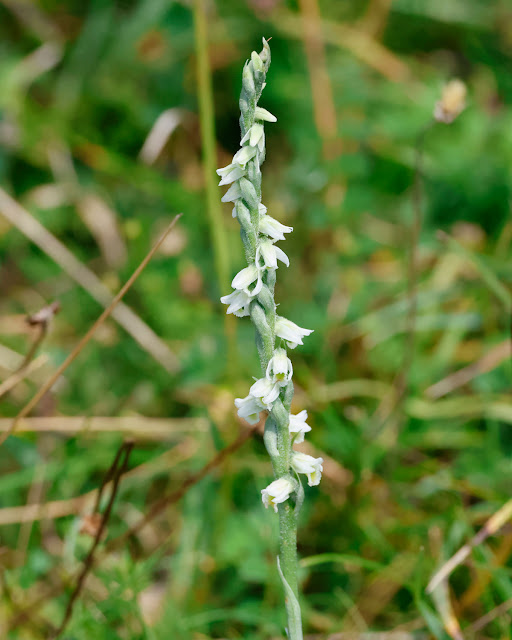Today was forecast to be the hottest day of the year, so where did I meet Ian, Old Winchester Hill of course. It was clear and sunny when I arrived, but away to the west the clouds looked to be dark. It was hot and humid at 9.00am but there was a pleasant breeze blowing from the south which eased the heat.
We set out across the top path. Once again there were very few butterflies about, one or two Meadow Brown and Gatekeeper, and of course Brimstone, that of all the butterflies appear to have had a good year. On reaching the main path to the Hill Fort, the field in front of us was only partially harvested.
We walked down the south slope, at first through ragwort and tall grasses, but as this became grass and thistles the Chalk Hill Blues appeared and in good numbers.
This male looking a little worn out.
Despite the early warmth it was nice to see them with the ir wings open in sunshine.
Having seen the Chalk Hills a few weeks ago we were now looking for the Silver=spotted Skipper and a late orchid, the Autumn Lady's Tresses. It was a little early in the day for the skippers, but we did manage to find the Autumn Lady's Tresses.
There was nowhere near the numbers we had seen last year and they were also not quite out in full flower. But it is possible to see the spiral effect of the flower positioning that gives them their name.
This probably the best of the lot.
The profusion of wild flowers at the bottom of the slope.
And in amongst them a Small Skipper.
A rather worn Brown Argus.
The patchwork of the fields, some harvested, some to be harvested and some left to grass.
We searched all over the area for any sign of the Silver-spotted Skipper, but couldn't find any at all. Typically they are a little late coming out here, usually about two weeks behind other sites which is strange given the southern aspect of the slope.
As we searched we were treated to a Red Kite drifting over.
The wings held still while the tail was working hard, changing the direction of the bird.
It drifted past me almost at eye level.
Then looking up the slope to the fort at first there was just one kestrel, but then other appeared, all immature birds, they were using the lift generated by the breeze coming up the slope and the side of the moat to practice their hovering and hunting skill.
They were totally unconcerned by us and at times would hover above us.
Then that dive towards the ground.
They would appear above the fort and drift both ways, sometimes squabbling with their siblings.
There would be frequent drops to the ground and while they were not catching rodents they were catching something.
Here it is a grasshopper that has been caught and was eaten on the wing, you can just make out the hind leg hanging out of the bill.
A rest on the Juniper bushes and then back up into the sky.
Then finally one almost next to us.
We walked up the slope, negotiated the fence and climbed up on to the moat top. A view looking west of the dark skies that did stay away from us.
Looking north a view of the split between the blue sky and heat and the clouds away to the west.
Walking around to the north side of the fort, we found a female Marbled White on the slope.
This is the latest in the year I have seen a Marbled White.
A Yellowhammer perched in the dead Ash trees.
We walked down the slope and through the wood. Coming out along the bottom there were more Chalk Hill Blues and a few Common Blues, but still no sign of any Silver-spotted Skipper. The walk up the slope and back to the car park was tough, it was now very hot and the slope was sheltered from the breeze that did cool things down.
After some lunch we decide to go back again, madness really in the heat, but we did. Armed with plenty of water we crossed the top path, then down and around the main slope. We walked down to the south slope bottom, but other than plenty of Chalk Hill Blues there was no sign of the skipper.
We could have walked back on the level, but we decided to carry on and walk through the wood to check the area at the bottom of the car park slope. More Common Blues and Chalk Hills and this lovely Brown Argus.
At the bottom of the slope, once again no sign of any skippers, but there was at least one more Autumn Lady's Tresses.
We walked up the final slope slowly, it was very hot and I did think I had been a little reckless to attempt the second walk, but all was well and the cold drink in the car was very welcome. It will mean another visit later in the month to find the skippers.













































No comments:
Post a Comment